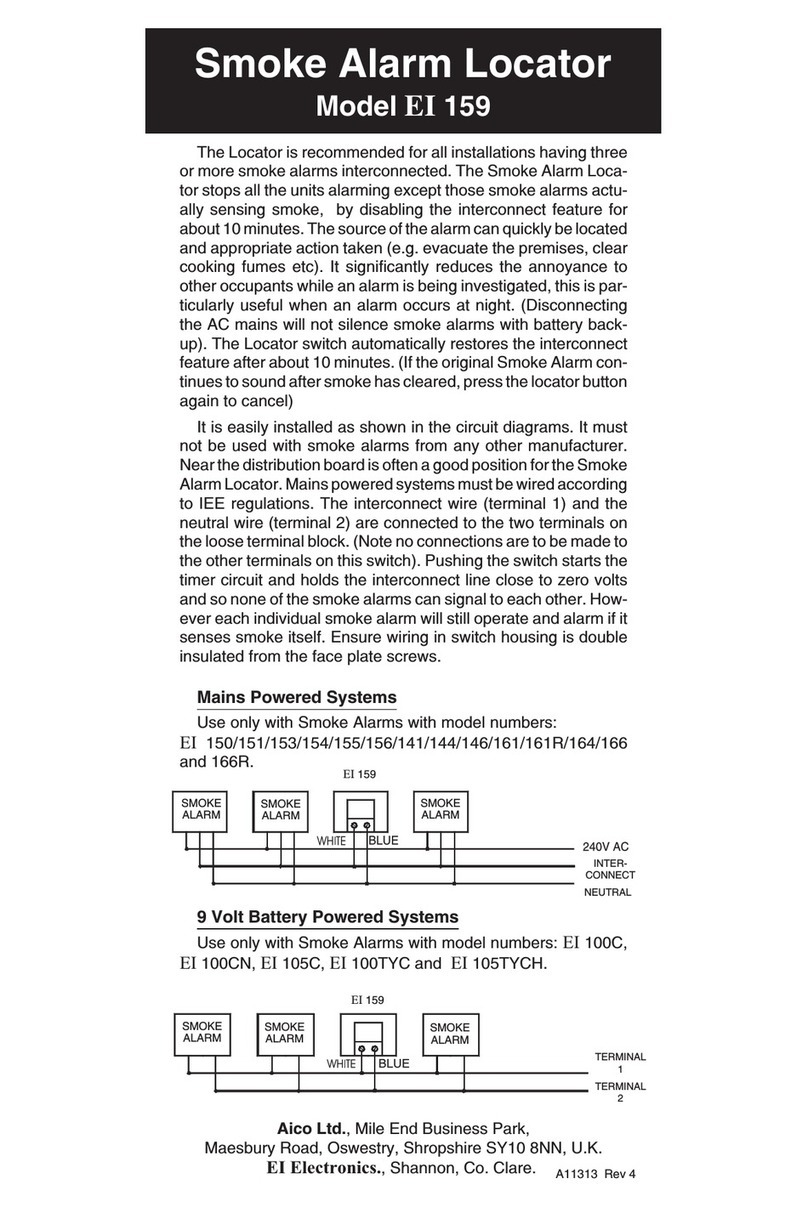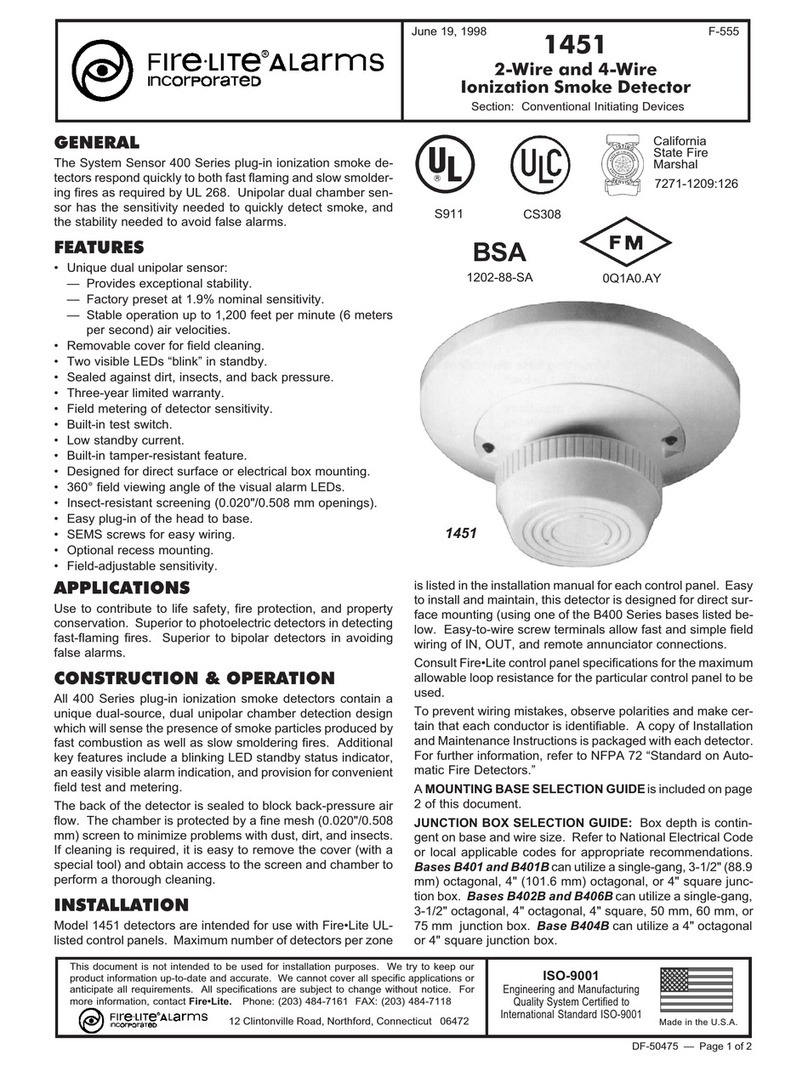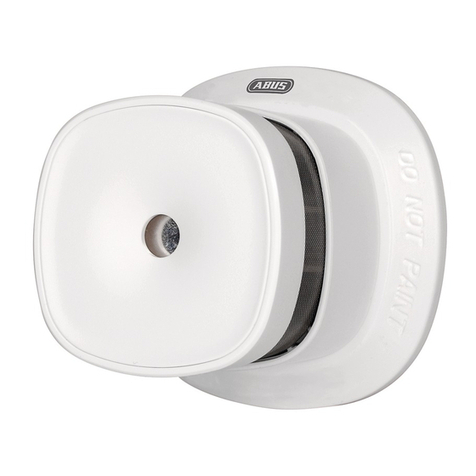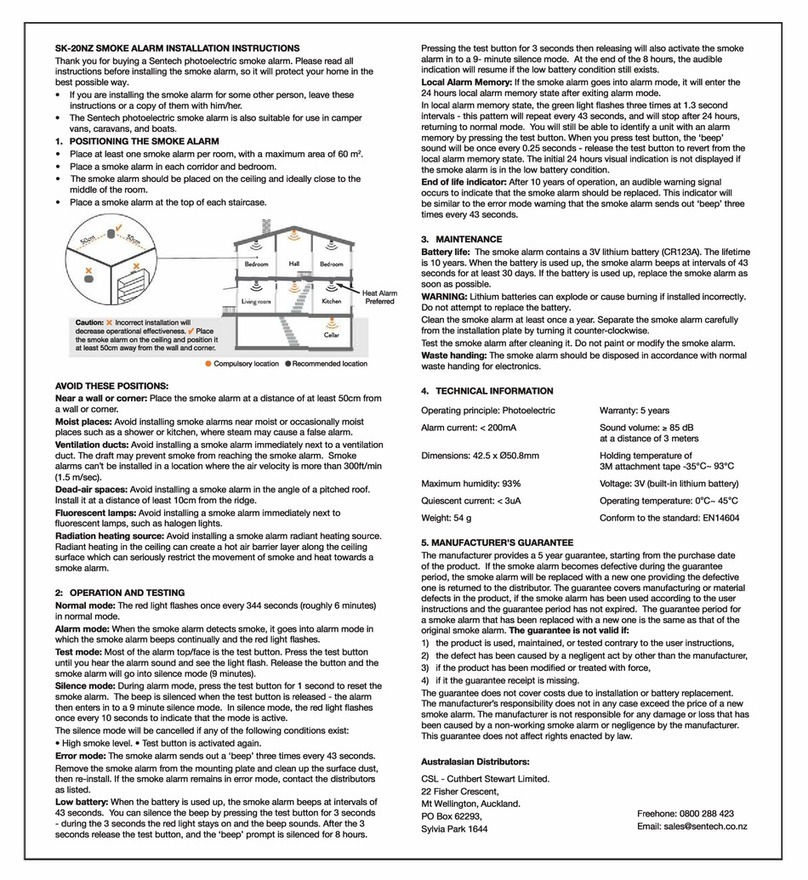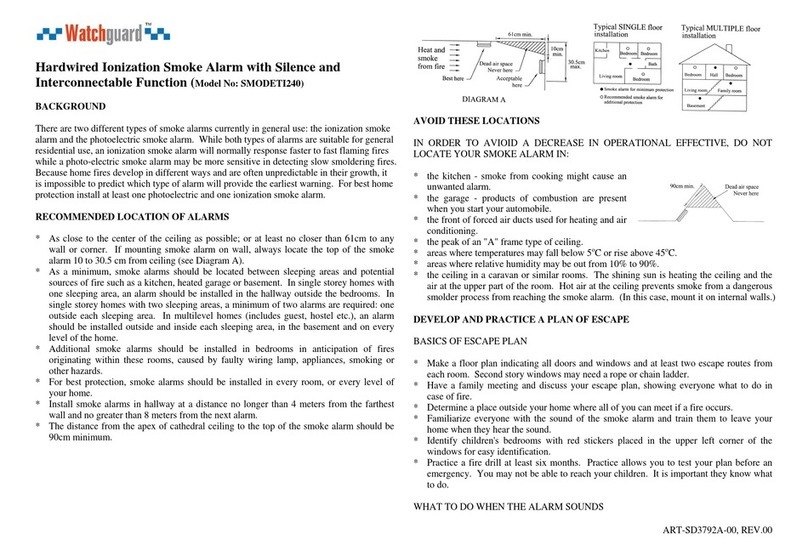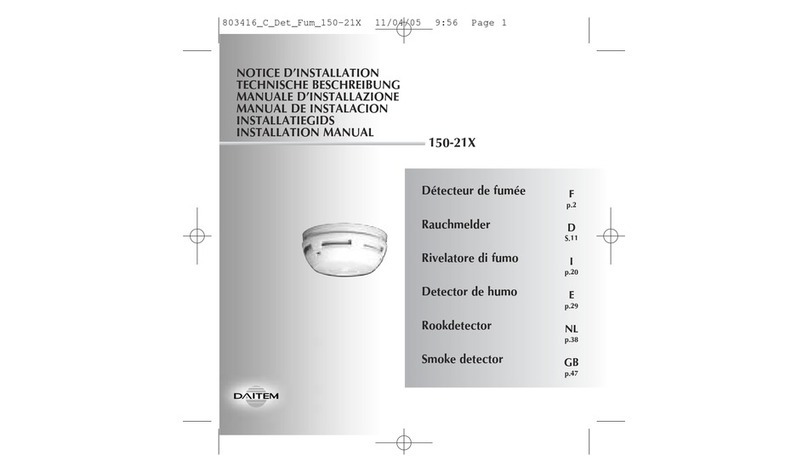SilentCall SD4-MC(US) User manual

PHOTOELECTRONIC SMOKE DETECTOR
WITH BUILT-IN WIRELESS TRANSMITTER
Installation and Operation Manual
Model # SD4-MC(US)
418 MHZTRANSMITTER
Document #
1081373126052

General Information
Before installing detectors, please thoroughly read these installation
instructions. For detailed information on detector spacing, placement,
zoning, wiring, and special applications refer to current edition of the
NFPA 72 National Fire Alarm Signaling Code.
NOTICE: Do not discard this manual. Manual should be left with the
owner/user of this equipment.
IMPORTANT: This detector must be tested and maintained regularly fol-
lowing NFPA requirements. Test detector operation weekly. The detec-
tor should be cleaned at least once a year.
NOTE: Smoke Detectors have a limited life. Smoke detectors should
be replaced immediately if not operating properly. You should always
replace a smoke detector after 10 years from date of purchase.
NOTE: Remove battery tab before installation.
NOTE: Radio Frequency device operates at 418MHz
FCC ID: PPJSD4418SC

General Description:
The Model SD4-MC(US) photocell electronic smoke detector with built-
in wireless transmitter is intended for use with the Silent Call® Mini
receiver to form an alerting system. The transmitter will send alarm
condition messages to the system’s receiver.
The SD4-MC(US) wireless transmitter operation is to be used only
with Silent Call® Medallion Series Receivers. The transmitted signal
incorporates a Million Code Address principle that provides each SD4-
MC(US) detector with a unique one in a million address. This helps to
keep any cross talk between like transmitters in a typical single living,
multi-dwelling, or apartment building to a minimum where it is possible
to have adjacent apartments with Medallion Series Receivers.
IMPORTANT: The range and proper operation of any wireless device
will vary depending on its surroundings. It is very important that each
SD4-MC(US) detector is tested with each receiver intended for Alarm.
The Model SD4-MC(US) incorporates a state of the art optical sensing
chamber and an advanced microprocessor. The microprocessor allows
the detector to automatically maintain proper operation at factory cali-
brated detection levels, even when sensitivity is altered due to the pres-
ence of contaminants settling into the unit’s smoke chamber. In order
for this feature to work properly, the chamber must never be opened
while power is applied to the smoke detector.

This includes cleaning, maintenance or screen replacement.
The Model SD4-MC(US) contains a piezoelectric horn which generates
the ANSI S3.41 temporal pattern in an alarm condition. During an alarm
condition, pressing the detector’s test switch will silence the piezo-
electric horn for 5 minutes. The built-in Drift Compensation algorithm
automatically maintains the sensitivity of the detector. The mounting
base installation is simplified by the incorporation of features compat-
ible with drywall fasteners or other methods that provide a method for
securing the detector in place.
Current studies have shown smoke detectors may not awaken all
sleeping individuals, and that it is the responsibility of individuals in the
household that are capable of assisting others to provide assistance to
those who may not be awakened by the alarm sound, or those who may
be incapable of safely evacuating the area unassisted.
Two LEDs and a sounder on the detector provide local visual and audi-
ble indication of the detector’s status:

Chirp every 45
sec after LED
blinks for 7 days
Temporal
Pattern
Off
Off
Off
Piezoelectric HornGreen LED Red LED
Off
Off
Off
Off
Blinks every 5
sec
Blinks every 5
sec
Blinks every 1
sec
Blinks every 45
sec
Blinks every 5
sec
Blinks every 10
sec
Low Battery
Smoke Alarm
Out of
Sensitivity
Normal
(Standby)
Power-up
Table 1: Detector LED Modes
During initial power-up, the red and green LEDs will blink synchronous-
ly once every 5 seconds. It will take approximately 20 seconds for the
detector to finish the power-up cycle (see Table 1).
After the power-up cycle has been completed and the detector is

functioning normally within its listed sensitivity range, the green LED
blinks once every 10 seconds. If the detector is in need of maintenance
because its sensitivity has shifted outside the listed limits, the red LED
blinks once every 5 seconds. When the alarm has been activated by
smoke, the red LED blinks every 1 second. The LED indication must
not be used in place of the tests specified under Testing. If the detector
senses a low battery condition, the red LED blinks once every 45 sec-
onds.
Low Battery Detection:
The Model SD4-MC(US) is powered by a single 3-volt CR123A Lithium
battery. The detector checks for a low battery at least every 65 minutes.
In addition, the red LED of the Model SD4-MC(US) will blink every 45
seconds and the test switch will be disabled. This condition will exist for
a minimum of 7 days, and then the detector’s horn will “chirp” about
every 45 seconds. Pressing the test switch during this time will silence
the chirps for 12 hours. The battery should be replaced BEFORE the
chirps begin. Be sure to replace the battery with a fresh one. Batteries
can be purchased directly from Silent Call Communications by calling
1-800-572-5227, or online at www.silentcall.com.

Battery Life Expectancy:
Replace the battery once a year or immediately when the low battery
indicator starts to blink and the horn begins to chirp.
Battery Installation and Replacement:
To replace the battery:
1. Remove the detector from its mounting base by twisting the detec-
tor counterclockwise. Remove the battery and dispose of it
properly.
2. To ensure proper power-down sequence, wait a minimum of 20
seconds before installing new battery.
3. Install a new approved 3-volt Lithium battery in the battery com-
partment. Follow the polarity diagram inside the compartment.
4. Reinstall the smoke detector onto the mounting base by turning
the detector clockwise.
5. The green LED should blink about once every 10 seconds to indicate
normal operation. If the battery is not installed correctly, the smoke
detector will not operate and the battery may be damaged. If the
detector does not appear to be sending a signal during any of the
tests, check for correct battery installation and for a fully charged
battery.
6. Test Smoke detector operation with Medallion Series Receiver to
verify proper operation.

NFPA Required Protection:
This smoke detector should be installed in accordance with the Nation-
al Fire Protection Association, Standard 72 (National Fire Protection
Association, Quincy, MA 002269). This detector will provide maximum
protection when installed in compliance with the National Fire Protec-
tion Association (NFPA). Standard NFPA 72, household fire warning
equipment
“For your Information, the National Fire Alarm and Signaling Code
NFPA reads as follows”
11.5.1* Required Detection
Where required by applicable laws, codes, or standards for a specific
type of occupancy, approved single and multiple-station smoke alarms
shall be installed as follows:
1. *In all Sleeping Rooms and Quest Rooms.
2. *Outside of each separate dwelling unit sleeping area, within 6.4 m
(21 ft) of any door to a sleeping room, with the distance measured
along a path of travel.
3. On every level of a dwelling unit, including basements.
4. On every level of a residential board and care occupancy(small fa-
cility), including basements and excluding crawl spaces and unfin-
ished attics.
5. *In living area(s) of a guest suite.
6. In the living area(s) of a residential board and care occupancy (small
facility).

(Reprinted with permission from NFPA 72®, National Fire Alarm Code
Copyright© 2007 National Fire Protection Association, Quincy MA
02269. This reprinted material is not the complete and official position
of the Nation Fire Protection Association, on the referenced subject
which is represented only by the standard in its entirety.)
(National Fire Alarm Code® and NFPA 72® are registered trademarks of
the National Fire Protection Association, Inc., Quincy, MA 02269.)

Recommended Locations for Smoke Detectors:
The National Fire Protection Agency (NFPA) recommends one smoke
detector on every floor, in every sleeping area, and in every bedroom. In
new construction, the smoke detectors must be AC powered and inter-
connected. For additional coverage, it is recommended that you install
a smoke detector in all rooms, halls, storage areas, finished attics, and
basements where temperatures normally remain between 4.4°C to
37.8°C. Make sure no door or other obstruction could keep smoke from
reaching detectors.
Specifically locate detectors:
• On every level of your residence, including basements and finished
attics.
• Inside every Bedroom, especially if people sleep with the doors
closed.
• Inside every bedroom where electrical appliances (such as portable
heaters or humidifiers) are operated where someone sleeps.
• At the bottom of the basement stairwell.
• At the top of the first-to-second floor stairwell, as long as no other
door or other obstructions block the path of smoke to the detector
• As close to the center of the ceiling as possible. If this is not practi-
cal, put the detector on the ceiling, but no closer than 4 inches (10
cm) from any wall or corner. See figure 1.
• If wall mounting is permitted by your local and state codes. Put the
top of wall-mounted detectors between 4 and 6 inches (10 and 15

PLACE ONE SMOKE ALARM ON EVERY FLOOR AND SLEEP ROOM
Figure 1: Recommended locations for
smoke alarms
MULTI-STORY
SINGLE LEVEL
cm) from the ceiling. see figure 1.
• Put a smoke detector at both ends of a bedroom hallway if the hall-
way is more than 40 feet (12 meters) long.

Best location
Acceptable location
Dead
Air
Space
Best in
center of
ceiling
No closer than 4 inch
(10 cm) from side wall
Mount on wall at least 4 inch
(10 cm) from ceiling
No more than 6 inches
(15 cm) from ceiling
Figure 1.2: Recommended smoke detector mounting locations.

• In rooms with sloped, peaked, or gabled ceilings, mount detectors
within 3 feet (0.9 meters) measured horizontally from the highest
point of the ceiling. See figure 2.
Horizontal
distance
from peak
3 feet
(0.9 m)
Figure 2: Recommended smoke detector location in rooms with sloped,
gabled, or peaked ceilings.

Where Smoke Detectors Should Not Be Located:
Nuisance alarms are caused by placing detectors where they will not
operate properly. To avoid nuisance alarms, do not place detectors:
• In or near areas where combustion particles are normally present
such as kitchens, in garages where there are particles of combus-
tion from vehicle exhausts, near furnaces, hot water heaters, or gas
space heaters. Install detectors at least 20 feet (6 meters) away from
kitchens and any other areas where combustion particles are nor-
mally present.
• In air streams passing by kitchens. Figure 3 shows how a detector
can be exposed to combustion particles in normal air movement
paths, and how to correct this situation.

Air Return
Bedroom
Bath
Air Flow
Stove
Kitchen
Correct
Bedroom Living Room
Incorrect
Figure 3: Recommended smoke detector locations to avoid air streams
with combustion particles.

• In damp or very humid areas, or next to bathrooms with showers.
The moisture in humid air can enter the sensing chamber as water
vapor, and will cool and condense into droplets that cause a nui-
sance alarm. Install detectors at least 5 feet (1.5 meters) away from
bathrooms.
• In very dusty or dirty areas. Dust and dirt can build up on the de-
tector sensing chamber and make it overly sensitive, or can block
openings to the sensing chamber and keep the detector from sens-
ing smoke.
• Near fresh air inlets or returns or excessively drafty areas. Air
conditioners, heaters, fans, and fresh air intakes and returns can
drive smoke away from smoke detectors, making the detectors less
effective.
• In dead air spaces at the top of a peaked roof or in the corners be-
tween ceilings and walls. Dead air may prevent smoke from reach-
ing the detector. See figures 4 and 5 for recommended mounting
location.
• In insect-infested areas. If insects enter a detector’s sensing cham-
ber they may cause a nuisance alarm. Get rid of the bugs before
installing detectors where bugs are a problem.

• Near florescent light fixtures. Electrical “noise” from nearby flores-
cent light fixtures may cause a nuisance alarm. Install detectors at
least 10 feet (3 meters) away from such light fixtures.
Limitations of Smoke Alarms
• Smoke detectors will not work without power. Battery operated
detectors will not work without batteries, with dead batteries, or
if the batteries are not put in properly. AC-powered detectors will
not work if their AC power supply is cut off by an electrical fire,
and open fuse or circuit breaker, or for any other reason. If you are
concerned about the reliability of either batteries or your AC power
supply for any of the above reasons, you should install both battery
powered and AC powered detectors for maximum safety.
• Smoke detectors must be tested regularly to make sure the batteries
and the alarm circuits are in good operating condition.
• Smoke detectors may not sense fires that start where smoke cannot
reach the detectors such as in chimneys, in walls, on roofs, or on the
other side of closed doors. If bedroom doors are usually closed at
night, detectors should be placed in each bedroom as well as in the
common hallway between them.
• Smoke detectors also may not sense a fire on another level of the
residence or building. For example, a second-floor detector may not
sense a first-floor or basement fire. Therefore, detectors should be
placed on every level of a residence or building.

• The horn in your detector meets or exceeds current audibility
requirements of Underwriters Laboratories. However, if the detec-
tor is located outside a bedroom, it may not wake a sound sleeper,
especially if the bedroom door is closed or only partly open. If the
detector is located on a different level of the residence than the
bedrooms, it is even less likely to wake up people sleeping in the
bedrooms.
• All types of smoke detectors have limitations. No type of smoke
detector can sense every kind of fire every time. In general, detec-
tors may not always warn you about fired caused by carelessness
and safety hazards like smoking in bed, violent explosions, escaping
gas, improper storage of flammable materials, overloaded electrical
circuits, children playing with matches or arson.
• Installing smoke detectors may make you eligible for lower insur-
ance rates, but smoke detectors are not a substitute for insurance.
Homeowners and renters should continue to insure their lives and
property.

Test Switch
Green LED
Red LED
Figure 4: Silent Call Model #SD4-MC(US) Wireless Smoke Detector
Programming
The smoke detector is pre-programmed at the factory.
Transmitter Setting
The Silent Call® system is digitally coded. The Medallion Series SD4-
MC(US) Smoke Detector is set to a unique million code setting at the
factory and therefore never requires the need of a different code.
Transmitter operates at a frequency of 418MHz.

Mounting
First, determine the best location for the smoke detector, one that pro-
vides a strong wireless transmission path and proper smoke detection.
A GOOD TRANSMISSION PATH MUST BE ESTABLISHED FROM THE
PROPOSED MOUNTING LOCATION BEFORE PERMANENTLY INSTALL-
ING THE DETECTOR. To check, perform the test described in the TEST-
ING SIGNAL STRENGTH section of this manual. To mount the detector,
perform the following steps:
1. Once a suitable location has been determined, install the mounting
base on the ceiling or on the wall (if local ordinances permit). Use
the two screws and anchors provided.
2. Turn the detector in a clockwise direction in the mounting base until
it clicks into place.
3. Test the detector immediately after completing the installation as
described in the TESTING section of this manual.
Popular Smoke Alarm manuals by other brands
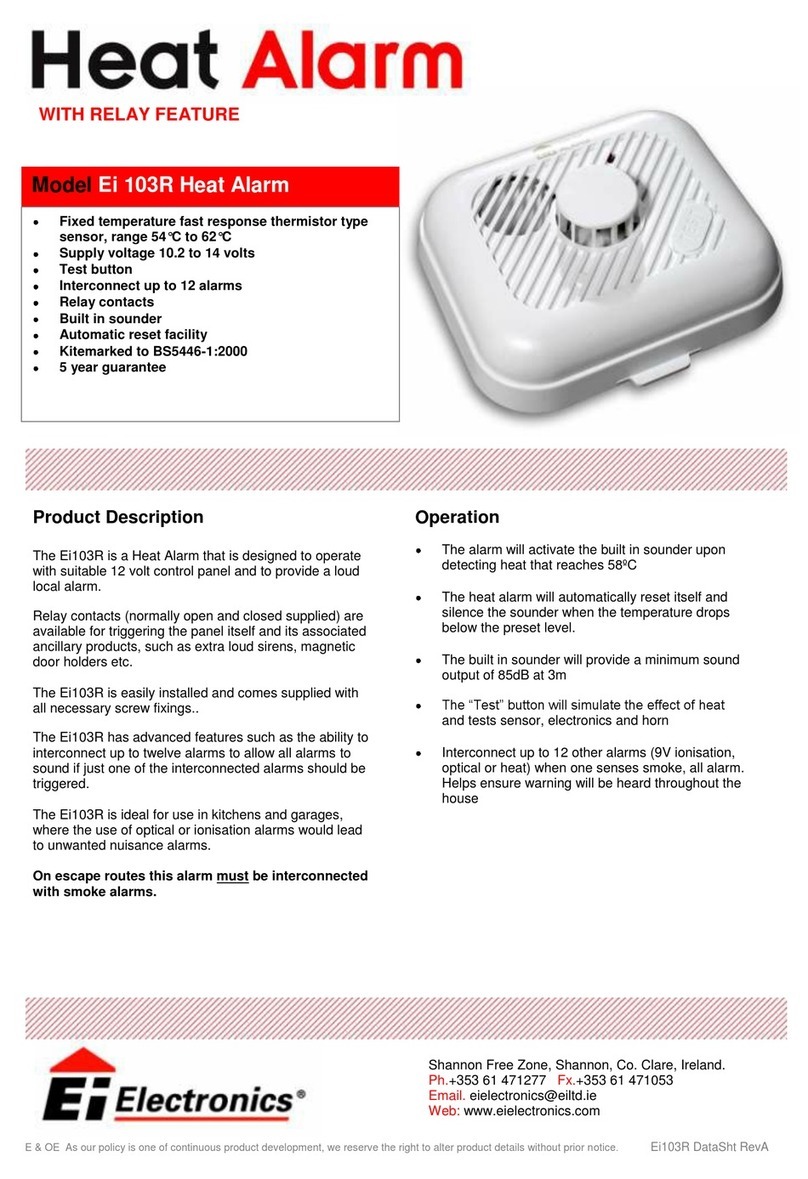
Ei Electronics
Ei Electronics Heat Alarm Ei 103R Technical specifications
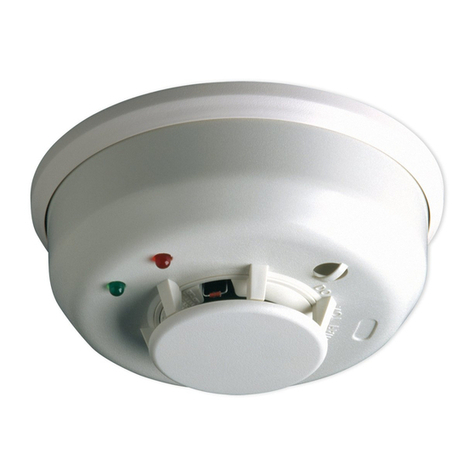
Honeywell
Honeywell Ademco 5806 W3 Troubleshooting
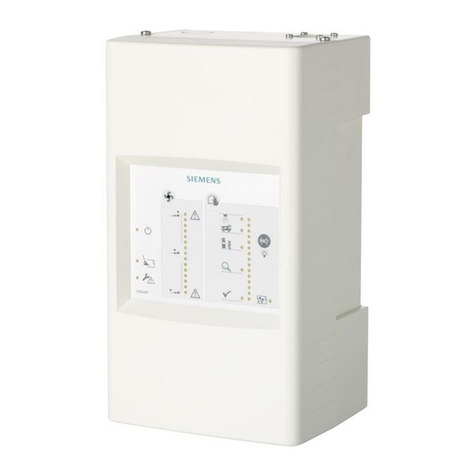
Siemens
Siemens FDA241 Mounting & installation
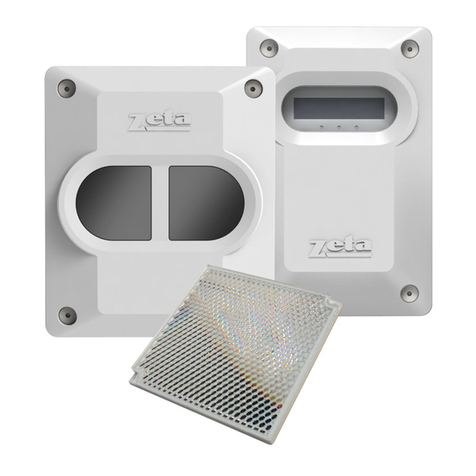
Zeta Alarm Systems
Zeta Alarm Systems Zeta Beam user guide
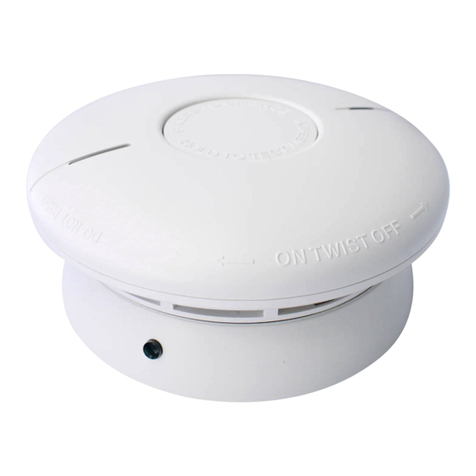
Yolink
Yolink YS7A01-UC Installation & user guide

UTC Fire and Security
UTC Fire and Security Kidde 900-0257 user guide

